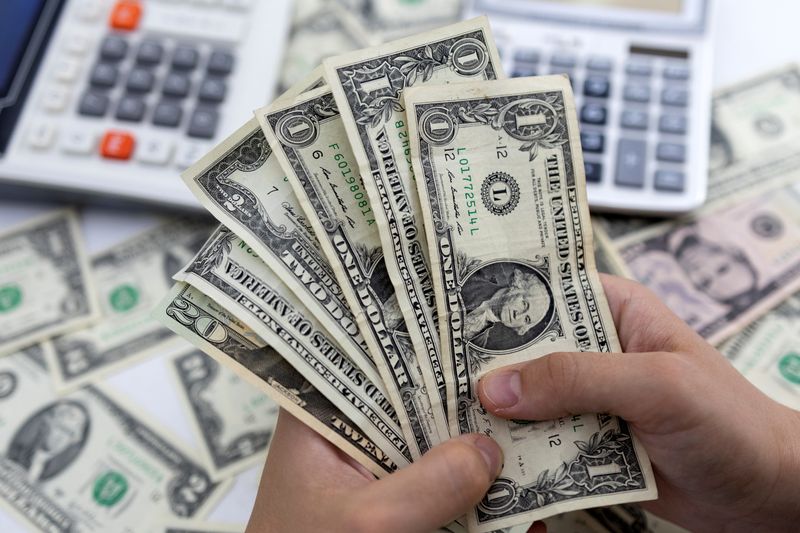Forex
US dollar rises broadly as inflation data underpins smaller Fed cut

By Gertrude Chavez-Dreyfuss
NEW YORK (Reuters) -The U.S. dollar gained on Friday after data showed a key inflation measure came in line with forecasts, while personal spending and income increased, supporting expectations the Federal Reserve will likely cut interest rates by a smaller 25 basis points next month, instead of 50 bps.
Some market participants had expected the larger cut next month on the notion that the Fed was behind the curve in terms of easing and should play catchup.
U.S. rate futures on Friday implied a 31% chance of a 50 basis-point rate cut next month, down from Thursday’s 35% probability, LSEG calculations showed, with the market fully pricing at the September meeting the Fed’s first easing in more than four years.
Markets have also factored in about 100 bps of cuts by the end of 2024.
The dollar rose 0.8% to 146.09 yen after the inflation data, for its largest daily gain in two weeks. It was up 1.2% for the week, on track for its biggest weekly rise since mid-June.
But the greenback remained down 2.6% for August, falling for a second straight month versus the Japanese currency.
Friday’s data showed the personal consumption expenditures (PCE) price index rose 0.2% last month, in line with expectations, after an unrevised 0.1% advance in June. In the 12 months through July, the PCE price index increased 2.5%, matching June’s gain.
Consumer spending was also 0.5% higher last month after expanding 0.3% in June.
“Obviously, we are going to get a rate cut, and I think that whether it’s 25 or 50, that’s still debatable and that will all depend on next week’s employment data,” said Peter Cardillo, chief market economist at Spartan Capital Securities in New York.
“I see three rate cuts and I see the possibility of a half a percent in September, depending on the employment data. If not, it’ll be 25-basis-point cut in September and then 50-basis-point cut in December.”
The , a gauge of its value against six major peers, climbed to a 10-day high after the inflation data and was last up 0.3% at 101.7. On the week, it rose 1%, on track for its best weekly performance since early April.
This month, however, the index fell 2.6%, its weakest since November last year.
The dollar overall continued to benefit from month-end flows, having been sold after Fed Chair Jerome Powell at a Jackson Hole gathering last week gave the clearest signal yet that the U.S. central bank will cut interest rates at the September meeting.
Separate economic reports showed that the University of Michigan’s monthly consumer sentiment index survey edged up to 67.9 in August from July’s eight-month low of 66.4, snapping a four-month slide. U.S. consumers see inflation continuing to moderate in the next year, the survey showed, with a gauge of price growth expectations published on Friday at the lowest level in August since late 2020.
The dollar briefly trimmed gains after the report.
In other currencies, the euro dipped 0.2% against the dollar to $1.1050. It has fallen 1.3% this week, on track for its largest weekly loss since April.
The euro, however, rose 2.1% in the month of August, for its best monthly showing since November 2023, with the European Central Bank still on track to lower interest rates again next month.
The single currency fell to a more than one-week low on Thursday and ended down 0.4% after German inflation cooled more than expected, bolstering investors’ expectations of ECB cuts.
The Chinese yuan firmed to a 14-month high against the dollar, for its biggest monthly jump since November, amid growing corporate demand for the Chinese currency as expectations heighten for U.S. rate cuts.
The strengthened as far as 7.0825 per dollar before last changing hands at 7.0920, on track for a rise of around 1.9% for August.
Currency
bid
prices at
30
August
08:02
p.m. GMT
Descripti RIC Last U.S. Pct YTD Pct High Low
on Close Change Bid Bid
Previous
Session
Dollar 101.67 101.36 0.32% 0.30% 101.78 101.
index 24
Euro/Doll 1.1053 1.1077 -0.21% 0.14% $1.1095 $1.1
ar 044
Dollar/Ye 146.16 144.96 0.89% 3.69% 146.25 144.
n 685
Euro/Yen 1.1053 160.6 0.6% 3.81% 161.62 160.
2
Dollar/Sw 0.85 0.8473 0.33% 1% 0.851 0.84
iss 68
Sterling/ 1.3131 1.317 -0.27% 3.21% $1.32 $1.1
Dollar 044
Dollar/Ca 1.3478 1.3485 -0.03% 1.69% 1.3509 1.34
nadian 66
Aussie/Do 0.6766 0.6798 -0.44% -0.73% $0.6817 $0.6
llar 752
Euro/Swis 0.9394 0.9385 0.1% 1.16% 0.9417 0.93
s 81
Euro/Ster 0.8417 0.8411 0.07% -2.9% 0.8428 0.84
ling 01
NZ 0.625 0.6257 -0.13% -1.11% $0.6275 0.62
Dollar/Do 31
llar
Dollar/No 10.6028 10.4989 0.99% 4.61% 10.6409 10.4
rway 767
Euro/Norw 11.7197 11.6308 0.76% 4.42% 11.7565 11.6
ay 137
Dollar/Sw 10.2664 10.2239 0.42% 1.98% 10.2936 10.2
eden 09

Euro/Swed 11.348 11.3231 0.22% 2.01% 11.382 11.3
en 17

 Forex3 years ago
Forex3 years agoForex Today: the dollar is gaining strength amid gloomy sentiment at the start of the Fed’s week

 Forex3 years ago
Forex3 years agoUnbiased review of Pocket Option broker

 Forex3 years ago
Forex3 years agoDollar to pound sterling exchange rate today: Pound plummeted to its lowest since 1985

 Forex3 years ago
Forex3 years agoHow is the Australian dollar doing today?

 Cryptocurrency3 years ago
Cryptocurrency3 years agoWhat happened in the crypto market – current events today

 World3 years ago
World3 years agoWhy are modern video games an art form?

 Commodities3 years ago
Commodities3 years agoCopper continues to fall in price on expectations of lower demand in China

 Economy3 years ago
Economy3 years agoCrude oil tankers double in price due to EU anti-Russian sanctions































